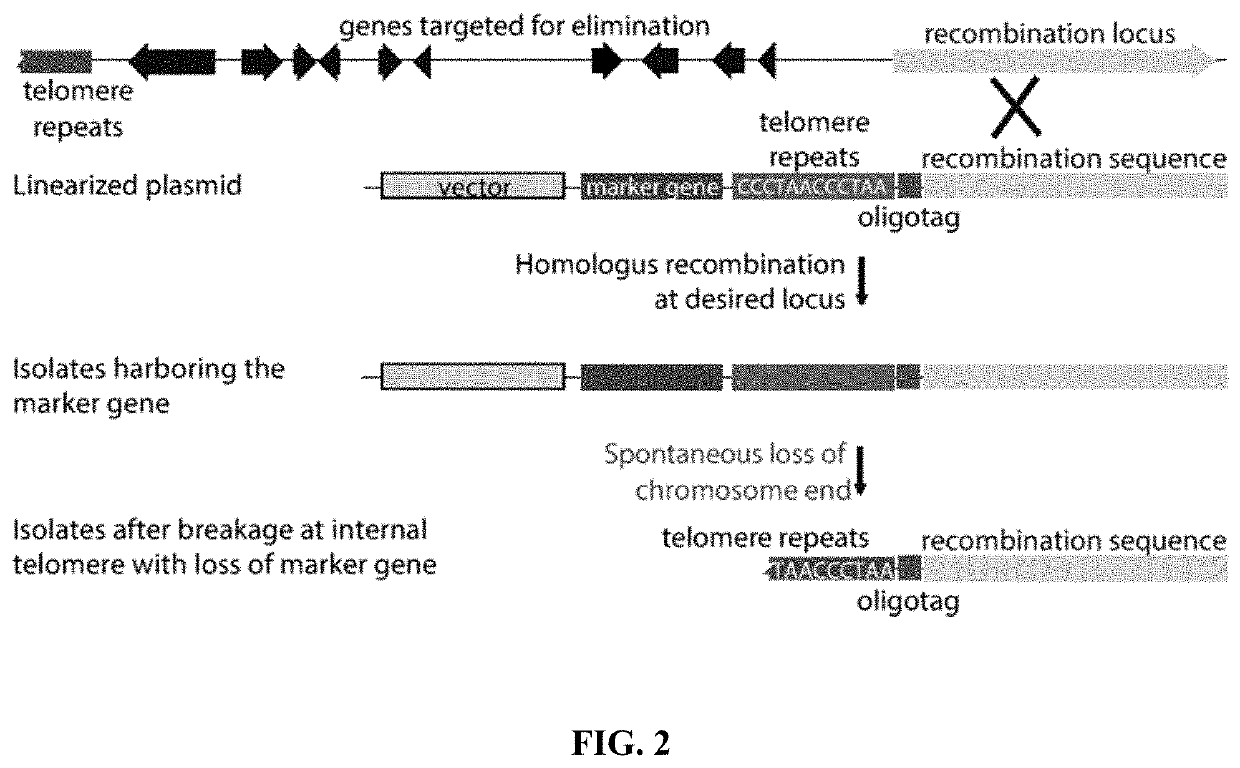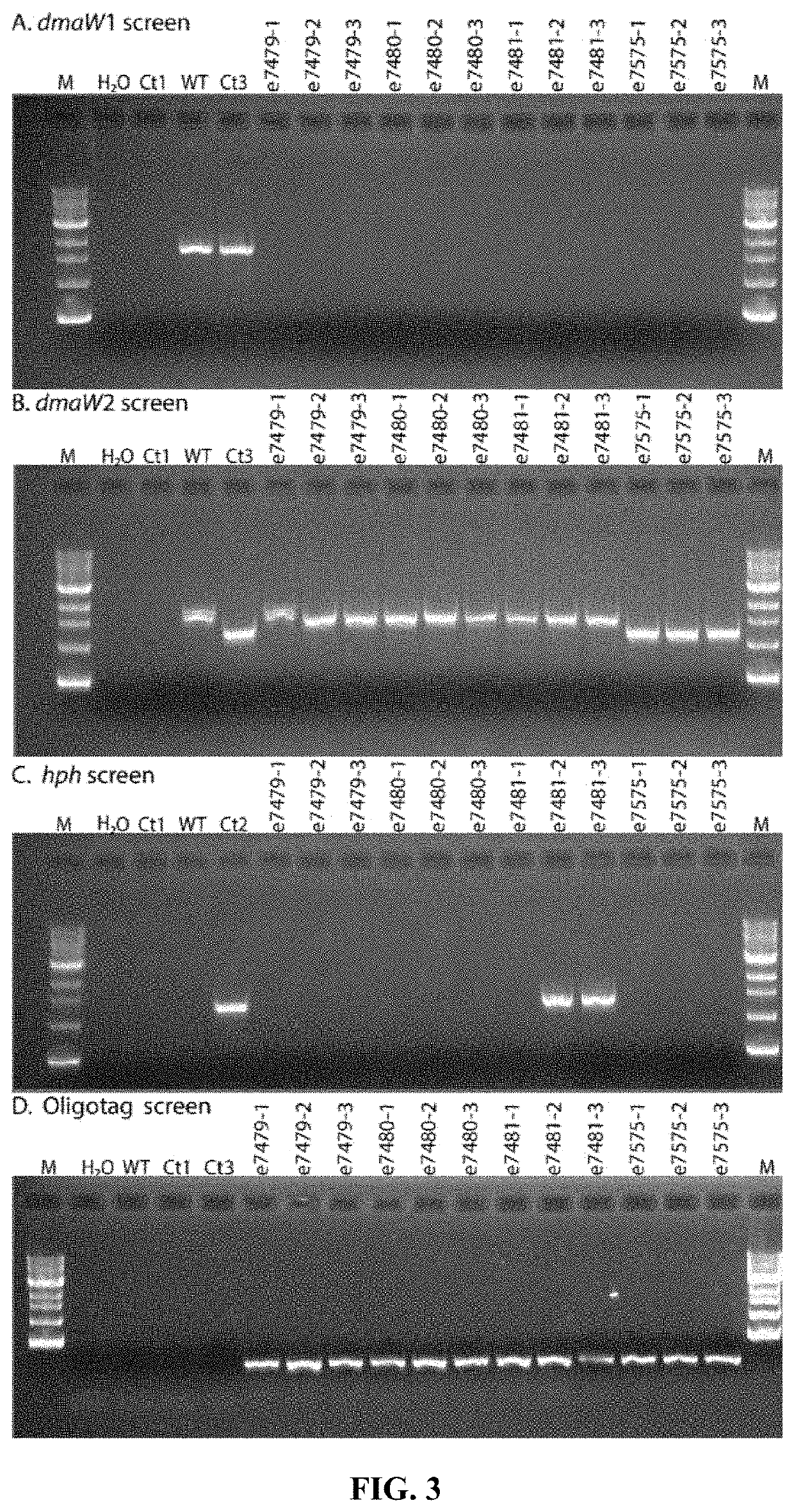Fungal chromosome-end knockoff strategy
a chromosome end and fungus technology, applied in the field of fungal chromosome end knockoff strategy, can solve the problems of reducing the endophyte benefits of reducing the benefits of endophyte benefits for pasture and forage production, etc., to achieve the effect of reducing the expression of toxins in the fungus
- Summary
- Abstract
- Description
- Claims
- Application Information
AI Technical Summary
Benefits of technology
Problems solved by technology
Method used
Image
Examples
example 1
[0123]Identification of EAS gene clusters in E. coenophiala. The genome assembly for E. coenophiala e19 included two copies each of the eleven EAS genes known to be required for ergovaline production (FIG. 1), although the assembly did not contain the EAS clusters entirely within individual scaffolds. As is typical of EAS clusters in Epichloë spp. (20), regions flanking and between EAS genes were primarily composed of very AT-rich repeats, which probably interfered with complete assemblies of the clusters. However, the previously reported genome sequence of another E. coenophiala strain, e4163, had one scaffold with its entire EAS1 cluster (GenBank KC989569.1) and another with its entire EAS2 cluster (GenBank KC989570.1) [19]. The cluster with genes most similar to those of E. festucae was designated EAS2, the other was designated EAS1, and the orthologous copies in e19 were identified by identity or near identity of their nucleotide sequences to those of the corresponding cluster i...
example 2
[0124]Identification of putative MAST chromosome-end knockoff strains. Transformation plasmid pKAES329 was constructed with a large segment of lpsA1 sequence to target homologous integration, an hph selectable marker modified for expression in fungi to confer resistance to hygromycin B, and a telomere repeat array adjacent to the lpsA1 sequence to eventually separate hph and the rest of the vector backbone from the lpsA1 sequence.
[0125]The lpsA1 gene fragment of SEQ ID NO:3 was used in chromosome-end knockoff vector pKAES329.
[0126]In a screen of 192 hygromycin B-resistant transformants of E. coenophiala e19, three were identified that tested negative for dmaW1 and positive for dmaW2, as expected if the linearized pKAES329 had integrated by homologous recombination at lpsA1, causing loss of the corresponding chromosome end. These three transformants were designated, with genotypes, as e7479 ΔEAS1, e7480 ΔEAS1 and e7481 ΔEAS1 (abbreviated as e7470, etc.). A similar screen of 67 transf...
example 3
[0127]Tests for spontaneous losses of vector sequences. For each of the putative knockoff strains, three single spores were randomly chosen and tested by the same PCR screen, confirming the apparent loss of dmaW1 and retention of dmaW2 (FIG. 3A, 4B). Without being bound by theory, spontaneous breakage at the internal telomere repeat was expected to lead to loss of hph and the vector backbone with all foreign DNA except the oligotag (FIG. 2). To check for such events, unselected single-spore isolates were screened by PCR for hph (FIG. 3C). For two of the transformants (e7479 ΔEAS1 and e7480 ΔEAS1) all single-spore isolates tested negative for hph, whereas for the third transformant (e7481 ΔEAS1) two out of three single-spore isolates tested positive for hph. All three unselected single-spore isolates from e7575 ΔdmaW2 ΔEAS1 tested negative for hph. These strains were also confirmed to contain the oligotag, based on PCR with one primer sequence contained within the oligotag and the ot...
PUM
| Property | Measurement | Unit |
|---|---|---|
| Tm | aaaaa | aaaaa |
| temperature | aaaaa | aaaaa |
| temperature | aaaaa | aaaaa |
Abstract
Description
Claims
Application Information
 Login to View More
Login to View More - R&D
- Intellectual Property
- Life Sciences
- Materials
- Tech Scout
- Unparalleled Data Quality
- Higher Quality Content
- 60% Fewer Hallucinations
Browse by: Latest US Patents, China's latest patents, Technical Efficacy Thesaurus, Application Domain, Technology Topic, Popular Technical Reports.
© 2025 PatSnap. All rights reserved.Legal|Privacy policy|Modern Slavery Act Transparency Statement|Sitemap|About US| Contact US: help@patsnap.com



